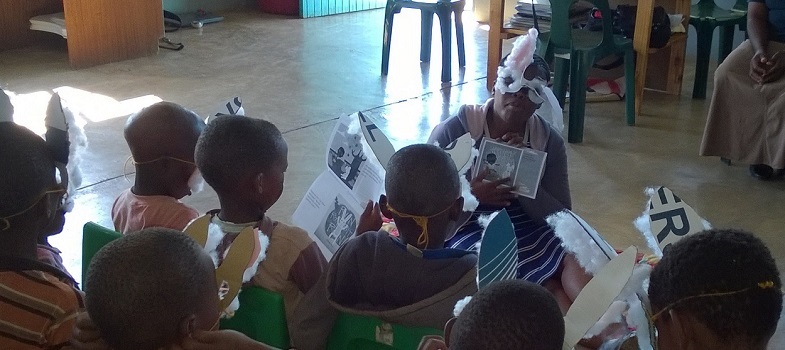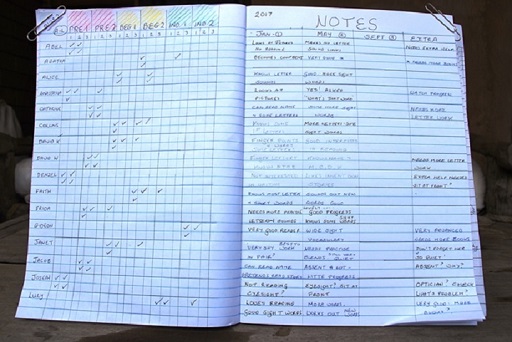Recording progress
In Case Studies 6.1 and 6.2 teachers are given a ‘snapshot’ of children’s reading development at a specific moment in time.
It is challenging for teachers, especially those with large classes, to:
- record each child’s progress over a year to ensure that they are moving forward with their reading
- use this record to make notes about ‘next steps’ for children
- create a record that can be useful to the next teacher, as children move up a grade.
In the next two case studies, you will see how teachers have devised ways of recording progress so that they can remember how children are developing and therefore plan appropriate activities for them.
Activity 6.3: Keeping records
Read the Case Study 6.3. As you read, note down the following in your study notebook:
- What opportunities will you have in a typical week to assess reading outside of literacy lessons?
- Why do you think Anne put the three target children in different groups?
- How does Anne use the information she gained through this process?
Case Study 6.3: A reading record book
Anne (see Case Study 6.1) decides to use the ‘stages of reading development’ chart in all her lessons – not just in English lessons. By doing this she can quickly make a note of how children are progressing with their reading.
As shown in Figure 6.1, Anne has made a class list in her mark book that includes six ruled columns labelled ‘Pre 1’, ‘Pre 2’, ‘Beg 1’, ‘Beg 2’, ‘Ind 1’ and ‘Ind 2’, as in the chart. There is also space for her to make notes for three reading assessments a year, plus an extra notes column.
Anne decides to observe four to six children each day during two separate lessons. With 60 children in her class, she can complete the class list in ten to fifteen days. She selects children alphabetically because this makes note-taking easier. Today it will be: Frida, Gideon and Janet in the first lesson, and Jared, Joseph and Lucy in the second.
Anne is doing a science lesson on parts of plants. She has written a title, ‘Parts of a plant’, and has drawn a plant on the board with the first letter of four key words: ‘leaf’, ‘stem’, ‘root’ and ‘flower’. She goes over the key words with the whole class and writes up the words in large print.
Anne then divides the class into small groups of four. Each group has a real plant to look at and four pieces of card with these four words on one side and the initial letters on the other side. Groups are asked to talk about the plant, take a card each and rehearse the names of each part. They then swap cards in the group and help each other to become confident with the words and plant parts. Every five minutes they change their plant with another group and repeat the cards activity. The whole class is busy and engaged. This gives Anne time to move to the groups that Frida, Gideon and Janet are in. Anne has a copy of the cards and a Grade 1 textbook with more writing about plants. She asks each of the three children questions appropriate to their reading level:
- Can you read the four initial letters ‘l’, ‘s’, ‘r’ and ‘f’?
- Can you read the words ‘leaf’, ‘stem’, ‘root’ and ‘flower’?
- What is the title of the diagram? (The answer is ‘Parts of a plant’.)
- Can you read this line from the Grade 1 textbook? (It’s a question that the children are not familiar with: ‘What parts of a plant do we eat? Root, leaf, stem, flower, seed or fruit?’)
Anne knows Frida is lively and likes to try and answer in class, but she finds reading difficult. She notices that Frida uses her finger to follow words and mostly starts at the left. Anne finds that Frida cannot give her the sounds of ‘P’, ‘L’ or ‘R’, but does know the sound of ‘F’ (for Frida!) and ‘S’ or ‘snake’ – a sound they’ve just been practising in class. Anne notes Frida down as ‘Pre 2’ and notes that Frida needs a lot more practice on initial sounds and a few sight words.
Anne knows that Gideon always puts his hand up to read from the board. She is confident he can read the words and the title, and quickly checks this. But can he read a question from the textbook that he hasn’t seen before? She shows him the textbook and asks him to read the first sentence. Gideon doesn’t use his finger and reads quite confidently: ‘What parts of a plant do we eat? Root, leaf, stem, flower, seed or fruit?’ ‘Seed’ and ‘fruit’ are new words: Gideon uses his knowledge of phonics to read ‘seed’, and blends ‘fr’ together to begin ‘fruit’. He hesitates – ‘–uit’ is an unusual spelling – but he makes a guess from the context and reads ‘fruit’. Anne notes Gideon down as ‘Ind 2’ and makes a note that she must give him extra books to extend his reading.
Janet is a very quiet girl who never puts her hand up. Anne is not sure how well she is progressing, but on her own, Janet is happy to have a go at reading. She uses her finger from left to right and knows all the initial letter sounds. She can slowly read the four familiar words. She struggles with the title ‘Parts of a plant’, as she reads ‘plant’ twice. She uses her finger on the textbook but can’t read ‘what’, and needs help from Anne to move across the rest of the sentence and recognise the familiar words in a different context. Anne notes Janet down as ‘Beg 1’ and makes a note that Janet will work best in a pair, not a large group, and is ready to begin blending sounds.
Whilst working with Frida, Anne notices that one of Frida’s group, Collins, is very eager to help Frida get the right answers. Although Collins is not on Anne’s target list today, she also quickly makes a note in the mark book that he knows all his initial letters and some sight words, and is now working at the ‘Beg 2’ level: Anne needs to check up on that!
Anne spends about five minutes with each child and is also able to keep an eye on the class’s group work. She then resumes the whole class lesson. After morning playtime, she will make notes on Jared, Joseph and Lucy’s reading progress during the literacy lesson.
It takes Anne two to three weeks to complete the class list; some days she is not able to cover as many observations, and some days she can do more. She is pleased with how much better she knows the children’s reading stages: who needs extra help and who needs to move to the next step. With this detailed information she can plan for some differentiated activities in future lessons, such as grouping children with others of a similar reading ability. The colours on the chart are useful here, for example in creating red, yellow and green groups. Anne can also plan for spending extra time with (red group) pre-readers. She decides to use this reading record book to add extra notes throughout the week – whenever she notices something specific about individual children, for example. Anne plans to repeat this detailed assessment of every child at least once a term, and will eventually pass her record book on to the Grade 3 teacher so that they will be well informed about each child’s reading progress.
This case study is also available to download. [Tip: hold Ctrl and click a link to open it in a new tab. (Hide tip)]
Anne created a page in her mark book to record her assessments. In the next activity, you will analyse and critically review Anne’s records.
Activity 6.4: Analysing Anne’s records
Look carefully at Figure 6.1.You will notice that Anne needs several pages for her 60+ class – the page shown in the figure has room to make notes on 16 children. On the left-hand page she has drawn red, yellow and green columns linked to the categories in the stages of reading development chart. She can add ticks to show the children’s reading level. On the right-hand page she has divided the pages into three main school terms. She can make short notes when she observes a child’s reading.
Can you answer the following questions?
- Which four children are independent readers?
- Look at the ‘Extra’ column on the right-hand page. What is Anne reminding herself to do for these independent readers?
- Which three children are still at the ‘Pre 1’ stage of reading?
- What has Anne written in the ‘Extra’ column for Denzel and Joseph?
- Anne writes that Janet is ‘very quiet’. Why might this worry Anne?
- Which child may be ready to be an independent reader by the third term: Alice or Catherine? Give a reason.
- Give two reasons why this record book helps Anne to track her class’s reading progress.
- Give two reasons why this record book will be helpful for the Grade 3 teacher next year.
Would you find Anne’s record sheet useful? What changes (if any) would you suggest?
Here are two downloadable resources to help you think about how to record progress in reading. If you have a large class, then Anne’s record will work best for you. If you have a small class, then it might be possible for you to create an individual record for each child.
If you have a mobile phone with a note-taking app, you may prefer to keep records on that. At the end of term, you would then be able to email your notes to another teacher.
Activity 6.5: Keeping reading records
Martin works in a small village school. He has 25 children in his class, with Grades 1 and 2 mixed together. He uses a record book like Anne’s for six months but finds it doesn’t have enough space to make detailed notes about each child.
Martin doesn’t have many children, but he does have the added challenge of a multi-grade class. So he decides to adapt the ‘stages of reading development’ chart and make a single-page record sheet for each child.
Look at Martin’s individual reading record for Paxima and consider the following:
- Look at Martin’s individual reading record for Paxima. In April, what sort of opportunities does he need to provide for Paxima to develop her reading? What should he be looking for?
- Do you think that you could also create individual record sheets for your class? Could you do this for each child? Would you do this only for children who you wish to monitor more closely?
- Could you use a note-taking app on your phone to keep records about your children? What would the advantages be of doing this? What would be the challenges?
- Discuss records with your colleagues. What are the advantages and disadvantages of whole class records and individual records? Think about the sort of records that would be useful you.
Assessing reading in your classroom




